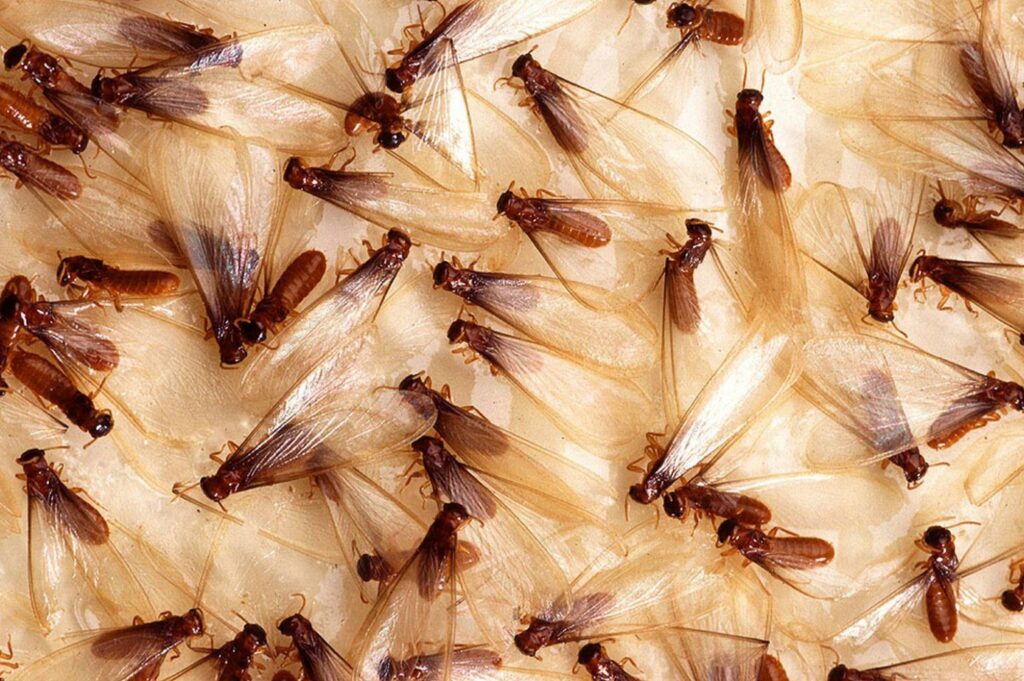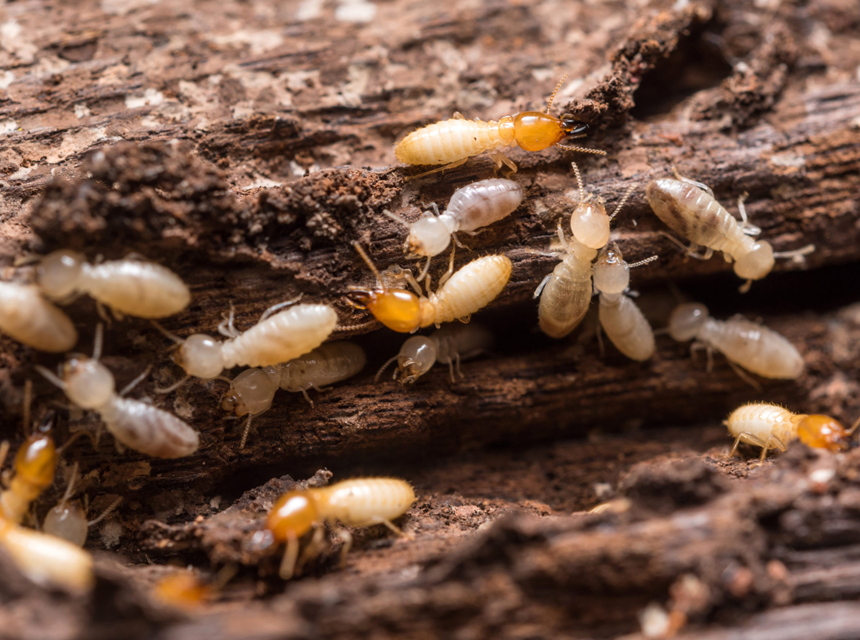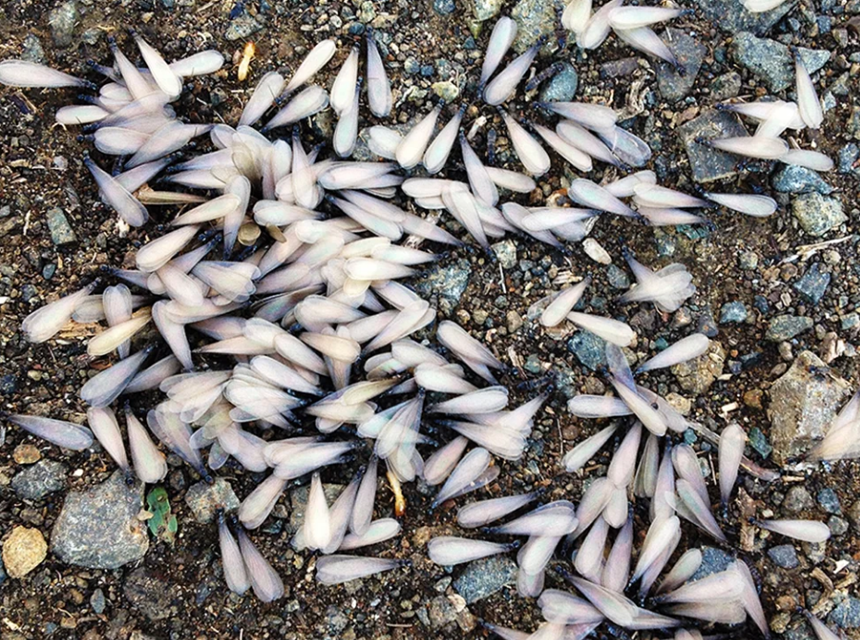

During rainy weather, you may see flying termites around your home. As a homeowner, dealing with a flying termite infestation can be the worst nightmare since it can cause extensive damage to your house. Their offsprings eat through wood, compromising the structural integrity of your home. As a result, your house may collapse, causing serious injuries and massive property damage. The worst thing is that you may not notice the damage until it is too late. So here, we give some tips on how to get rid of flying termites.
Telling whether your home has a termite infestation or not can be difficult. However, you can look out for signs such as mud tubes around your home, wood damage, and drywood termite droppings. If your home has a termite infestation, you need to look for ways to eliminate these pests.
Identifying flying termites is quite easy. The first factor that can help you identify these pests is their wings. Flying termites have two pairs of translucent wings about three centimeters long on each side of their body. These wings are usually equal in size and have several veins.
Another thing that can help you identify flying termites is their color. Typically, flying termites are gold in color. They also have two tiny and straight antennae.
There are over 2000 species of flying termites. Although these pests have distinguishing characteristics, they look almost similar, and you may find it difficult to tell them apart.
Some of the common species include:
A termite life cycle comprises three main stages, as seen below.
Egg – The life cycle of a termite begins as an egg. Once fertilization occurs, the female termite lays eggs. On average, a termite lays up to 30,000 eggs in a day. These eggs are usually tiny and white. Therefore, you cannot see them with your naked eyes. After a few weeks, these eggs will hatch.
Nymph – Termite eggs hatch into nymphs with pale, white exoskeletons. Nymphs look like small termite adults with six legs and antennae. During this phase, termite nymphs develop through molting Trusted Source Molting in workers of the Formosan subterranean termite Coptotermes formosanus The Formosan subterranean termite, Coptotermes formosanus, with its huge colonies, is a major urban pest in several southern states and Hawaii as well as in South Asia. pubag.nal.usda.gov . They shed their skin and become lighter. As time goes by, the nymphs grow bigger and evolve into different castes depending on their hormonal composition.
Adult – After some time, a termite nymph develops into an adult. The amount of time a nymph takes to develop into an adult depends on colony population and temperature. Food availability is also a determining factor. Once termites become adults fully, they form colonies.
There are several things that attract termites into your home. Some of them include:
Wood – Flying termites like wood since it is their main food source. Wood also offers shelter to some termite species. Most people use wood when constructing specific parts of their homes, including floors and the ceiling. Therefore, these termites may find their way into your home, searching for food and shelter.
Moist Soil – Some termite species, especially the subterranean termites, like staying in moist soil. Typically, the soil around your home’s foundation contains a lot of moisture. Leaky faucets and poor gutter drainage can also make the soil around your house retain excessive moisture.
Openings in the exterior part of your home – The concrete covering the exterior part of your home can develop cracks due to exposure to extreme weather conditions or natural way and tear. These cracks can encourage termites from the nearby soil to enter your home, no matter how tiny they are.
Where you live – If you live in a cold region, flying termites and ants are likely to come into your home searching for warmth. These pests may infest your carpet, causing irreversible damage. If you experience such a problem, you may want to consider the best carpet ant killers.
Termites are attracted to light sources, especially straight light. Therefore, if you have a termite infestation, you are likely to see many termites flying around your bulb at night.
Termites flying around your bulb can be annoying. The best way to deal with these pests is by turning off the lights and opening your doors to allow them to fly out quickly without dropping their wings in your house.
Flying termites are usually confused with flying ants. When you take a quick look at these insects, you may not tell them apart since their color, shape, and size are almost similar. However, there are some significant differences you need to be aware of.
The first feature that separates these pests is their wings. Both insects have two pairs of wings on each side of the body. However, the flying termite’s wings are equal, while the flying ant’s top wings are twice the bottom wings.
Another factor that distinguishes these two pests is their antennae. The flying termite’s antennae are straight, whereas the flying ant’s antennae are bent at a 90-degree angle.
Finally, the flying termites have a bigger body compared to the flying ants.
The video below shows how to identify flying termites in your home.
Most homeowners prefer using natural DIY methods to get rid of flying termites from their homes. Here are some examples.
One of the best methods you can use to get rid of termites in your house naturally is boric acid. Boric acid is simply a powder substance that kills termites. Once termites eat the powder, it disrupts their digestive system. Therefore, they won’t get any nutrients and will die after 72 hours.
To ensure the powder kills all the flying termites in your home, apply it around your home’s perimeter. You should also apply the acid to your house’s entry points like the doors, basement vents and windows.
Other than wood, flying termites also feed Trusted Source Termite - Diet and Communication | Britannica The food of termites is mainly cellulose, which is obtained from wood, grass, leaves, humus, manure of herbivorous animals, and materials of vegetative origin. Some termites construct spongelike fungus gardens and practice controlled cannibalism. The continuous exchange of information in the colony is communicated by vibrations, chemical signals, and physical contact. www.britannica.com on plants. Therefore, if you have potted plants in your home, they will attract termites into the house. Additionally, growing plants near your house will attract termites, and they may eventually find their way into your home.
In such a case, you need to use rubber mulch made from recycled tires. Generally, rubber does not contain cellulose. Therefore, it won’t attract termites as much as wood does.
Nematodes are parasitic worms that help you get rid of termites from your home by hunting them down. All you need to do is mix the warms in water and spray the solution in the infested areas. Once the termites feed on them, they will release poison into their digestive system and kill them eventually.
Once the worm kills the termite, it will move to the next victim. Therefore, beneficial nematodes can be an ideal long-term solution for getting rid of termites.
Another effective way to get rid of flying and flying termites from your home naturally is through essential oils. The most preferred essential oil to kill termites is the orange oil extracted from an orange fruit’s rinds.
Orange oil contains D-limonene, which dissolves a termite’s exoskeleton once it comes into contact with it. The termite then becomes dehydrated and loses its ability to synthesize nutrients. Eventually, the pest dies.
Besides orange oil, tea tree oil and neem tree can also get rid of termites from our home by repelling them. Neem oil also has a chemical composition that affects the termite’s reproductive system, preventing the pest from laying eggs. As a result, they won’t multiply.
Cayenne paper is one of the easiest methods you can use to get rid of termites from your home naturally since this substance is readily available. This powder contains capsaicin that irritates the pest’s exoskeleton. This substance also kills termites by affecting their digestive and nervous systems.
If you want this powder to be more effective, sprinkle it directly on the termites’ trail. You can also mix it with vegetable oil and apply the paste to the infested areas of your home.
A zapper is a lamp-like equipment that produces UV light that attracts flying termites and kills them as soon as they enter the trap. The equipment also comes in a racket form. According to most reviews, the best racket bug zapper is the 4000V Rechargeable Electric Bug Zapper from JANMASH. This is the best method to use since it does not require preparation.
For the equipment to be effective, place it in one corner of your room or hang it on your balcony.
You can use chemicals to get rid of termites completely from your home. There are several types of chemicals that can help you control Trusted Source Pest Control - Termites Additional methods of termite control include baiting, dusting and creating chemical barriers around the building. www.health.vic.gov.au termites. Some come in liquid form, while others are in powder form.
However, these chemicals are toxic. Therefore, you need to handle them properly. Otherwise, you risk causing a chemical accident. Additionally, ensure you apply the chemical properly to ensure it kills the termites.
Here are steps you can follow to eliminate flying termites from your home.
If you want to know whether your home has a termite infestation or not, inspect your home regularly. During the inspection, look for signs of termite infestation like mud tubes along your house’s foundation, walls or wooden beams. You can also look around for small wood pellets.
Most homeowners try to get rid of flying termites from their homes naturally using DIY solutions. Although these methods may work, they may not be effective for a long time, and you may experience reinfestation. For this reason, you need to seek professional assistance.
These experts have the necessary tools to eliminate flying termites completely. Moreover, they have the necessary experience.
If you prefer using DIY solutions to get rid of flying termites, begin with the barrier treatment. This step is essential since it prevents termites from getting into your home. However, ensure you follow all directions properly.
The best way to eliminate a termite infestation is by using termite baits. These are stakes placed on the ground around the infested region in your house to attract termites.
Once a termite feeds on the stakes, it carries the poison into the nest and spreads it. After a few days, the poison will kill the entire colony. If you are looking for a termite bait, consider the Compressed Termite Bait from Trelona. According to most reviews, it is the best termite bait.
There are various steps you can follow when you want to get rid of termites from your yard, as discussed below.
Before handling a termite infestation in your yard, you need to look for a chemical that can kill the pests. If you use the wrong chemical, the termites will not die. Some chemicals also don’t seep into the soil, killing only the termites on the surface. Finally, some chemicals can harm the plants nearby. According to most reviews, the best chemical that you can use to kill termites in your yard is the Home Perimeter Treatment Termite Killer 700350A from BioAdvanced
Some homeowners usually try to get rid of termites by shoveling them and taking them to another location far from their homes. However, this solution is ineffective since the termite colony is most likely hidden and active termites are already spread throughout the yard.
Additionally, disturbing the termites can make them migrate to another location in your yard or move into your home.
Using pine sleepers to build a raised garden bed cannot help you eliminate flying termites. In fact, the wet sleeper wood provides an ideal environment for them.
Furthermore, pine sleepers have been treated with deltamethrin. When you water your plants, this chemical slowly leaches into your soil and may find its way into your vegetable, causing a health risk.
● Fill the cracks in your home
● Get rid of firewood piles near your home
● Use a varnish solution to protect wooden surfaces in your home
● Fix leaking faucets to prevent moisture from accumulating in your home
● Use termite monitoring stations
● Apply pest repellents in your home
Dealing with a termite infestation in your home can be frustrating. Therefore, you need to be on the lookout to prevent these pesky pests from infesting your home. However, if your home is already infested, you can call a professional to help you get rid of them. Although these experts have the necessary chemicals, tools, and expertise to help you deal with this issue, they can be expensive. If you don’t have enough money, consider using natural DIY solutions. If you use these methods correctly, you will not deal with termite infestation for some time. We hope that this guide on how to get rid of flying termites will be useful to you!





